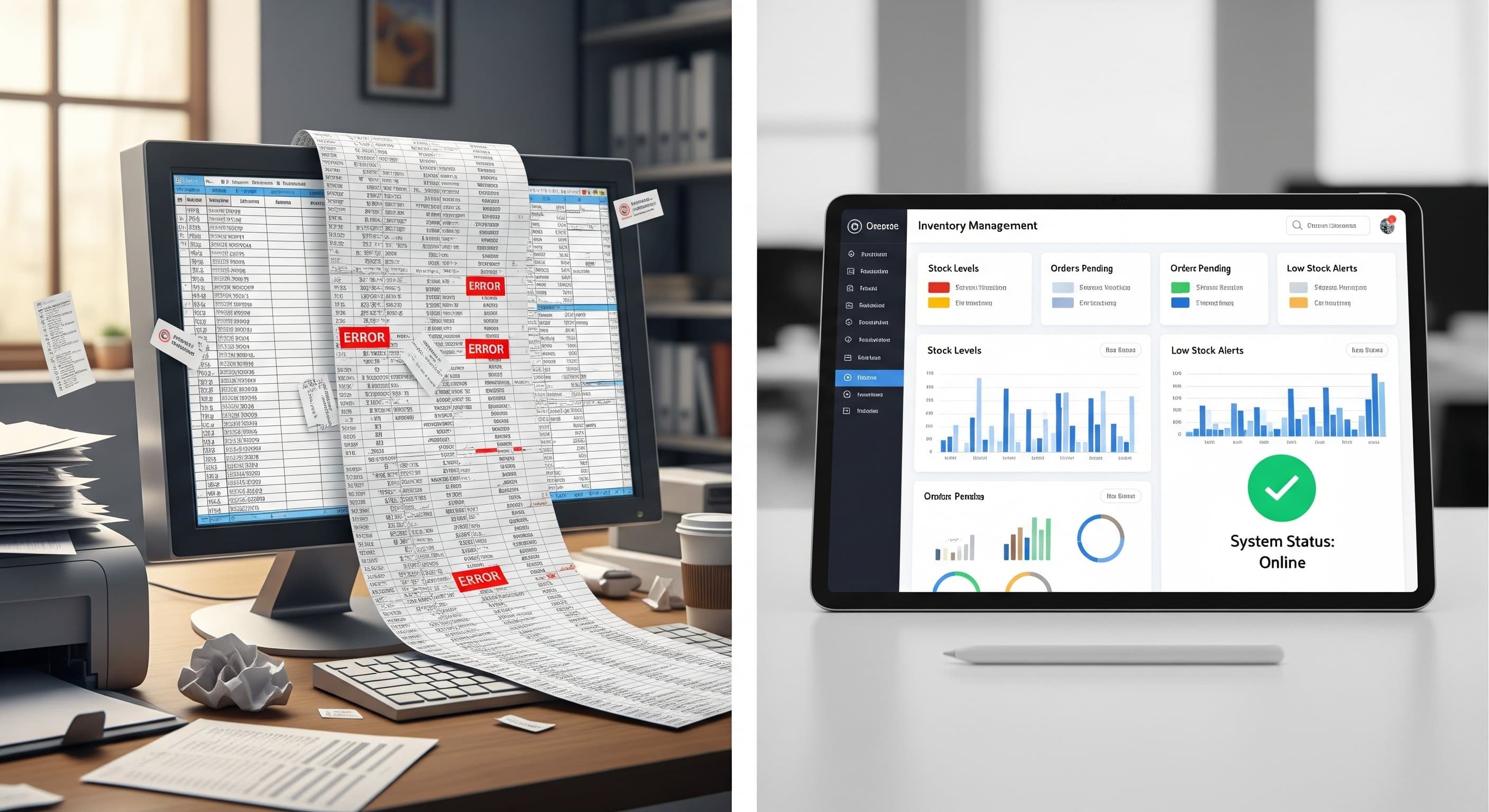5 Signs You've Outgrown Spreadsheets for Inventory Management
Still running your inventory on spreadsheets? Discover five clear signs your business has outgrown them—and why upgrading to a modern inventory management system can save time, cut errors, and boost growth.

For many startups and small businesses, spreadsheets are the go-to tool for managing inventory. They're accessible, affordable, and seemingly straightforward. However, as your business flourishes and your operations expand, the very tool that once helped you grow can become a significant bottleneck. The cracks in a spreadsheet-based system begin to show, leading to costly errors, wasted time, and missed opportunities.
If you're wondering whether your business is reaching this critical turning point, here are five clear signs that you've outgrown spreadsheets and it's time to upgrade your inventory management system.
1. The Alarming Rise of Human Error
That sinking feeling when you realize a simple typo has led to a major stock issue is a classic symptom of an over-reliance on spreadsheets. Manual data entry is inherently prone to mistakes. A misplaced decimal, an extra zero, or a copy-paste error can have a domino effect, leading to:
- Stockouts: Inaccurate stock counts can result in selling items you don't actually have, leading to disappointed customers and canceled orders.
- Overstocking: Believing you have less of a product than you do can lead to unnecessary reorders, tying up valuable cash in dead stock and increasing carrying costs. Industry estimates suggest that carrying costs for excess inventory can range from 15% to 30% of the product's value annually.
- Shipping Errors: Incorrect inventory data can lead to shipping the wrong item or quantity, resulting in costly returns and a damaged reputation.
As your order volume and product catalog grow, the likelihood of these human errors multiplies, directly impacting your bottom line.
2. "Who Has the Latest Version?" - The Lack of Real-Time Data
In a dynamic business environment, making decisions based on outdated information is like driving with your eyes on the rearview mirror. Spreadsheets are static documents. When multiple team members need to access and update inventory information—from the warehouse floor to the sales desk—version control becomes a nightmare.
This lack of real-time visibility means:
- Your sales team might promise a product to a customer that your warehouse team just allocated to another order.
- Your purchasing manager might reorder stock, unaware that a large return was just processed.
- You can't get an accurate, up-to-the-minute snapshot of your inventory health, leading to guesswork and reactive decision-making.
Modern inventory management requires a single source of truth that is updated instantly as sales are made, shipments are received, and stock is moved.
3. Drowning in Manual Data Entry
Remember when updating your inventory spreadsheet took just a few minutes a day? As your business grows, that time commitment expands exponentially. Studies have shown that workers can spend over 40% of their time on manual, repetitive tasks, including data entry.
Think about the hours your team spends each week:
- Manually adding new stock arrivals.
- Updating quantities for each sale across multiple channels.
- Reconciling inventory after a stock take.
This is valuable time that could be spent on strategic activities like marketing, customer relationship building, or new product development. If your team is spending more time managing spreadsheets than growing the business, it's a clear sign your current system is inefficient.
4. Forecasting is More of a Guessing Game
Accurate demand forecasting is crucial for optimizing stock levels, ensuring you have the right products at the right time. While a spreadsheet can hold historical sales data, extracting meaningful insights is a cumbersome and often manual process.
Without a sophisticated system, you'll struggle to:
- Identify seasonal trends: Easily see which products peak during certain times of the year to plan accordingly.
- Set accurate reorder points: Automatically get alerts when stock for a specific SKU hits a minimum threshold.
- Analyze sales velocity: Understand how quickly different products sell to make smarter purchasing decisions.
Effective forecasting relies on accessible, easily analyzable data. A sprawling spreadsheet often makes this task so complex that businesses either avoid it or rely on gut feeling, which is a risky strategy in a competitive market.
5. Your Systems Don't Talk to Each Other
In today's interconnected e-commerce landscape, your inventory management system shouldn't be an island. If you're selling on multiple platforms (like Shopify, Amazon, or a physical store), a standalone spreadsheet creates data silos.
This lack of integration means:
- Manual updates for each sales channel: A sale on your website needs to be manually reflected in the spreadsheet, and then that information isn't automatically shared with your other sales channels, increasing the risk of overselling.
- No seamless connection to other business tools: Your inventory data doesn't automatically sync with your accounting software or your shipping provider, requiring duplicate data entry and increasing the chance of errors.
This disjointed approach not only wastes time but also prevents you from having a holistic view of your business performance.
The Way Forward: Embracing a Smarter Solution
If these signs resonate with you, don't be discouraged. It's a natural part of a growing business to outgrow its initial tools. The good news is that there's a clear path forward.
Modern inventory management SaaS (Software as a Service) solutions are designed specifically to solve these challenges. They automate data entry, provide real-time updates across all your channels, offer powerful reporting and forecasting tools, and integrate seamlessly with the other software you use to run your business.
By moving away from error-prone, time-consuming spreadsheets and embracing a centralized, automated system, you can save money, make smarter decisions, and free up your team to focus on what truly matters: delighting your customers and continuing to grow.



